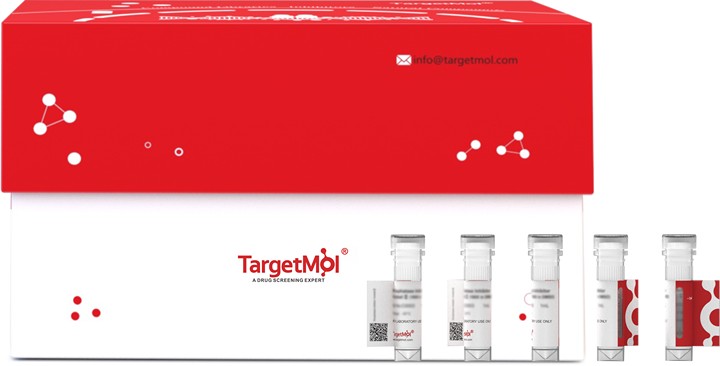Shopping Cart
Remove All Your shopping cart is currently empty
Your shopping cart is currently empty
CD40 ligand or CD40L, also called CD154, is a protein that is primarily expressed on activated T cells and is a member of the TNF superfamily of molecules. It binds to CD40 (protein) on antigen-presenting cells (APC), which leads to many effects depending on the target cell type. In total CD40L has three binding partners: CD40, α5β1 integrin and αIIbβ3. CD154 acts as a costimulatory molecule and is particularly important on a subset of T cells called T follicular helper cells.

| Pack Size | Price | USA Warehouse | Global Warehouse | Quantity |
|---|---|---|---|---|
| 5 μg | $51 | Inquiry | Inquiry | |
| 10 μg | $80 | Inquiry | Inquiry | |
| 20 μg | $129 | Inquiry | Inquiry | |
| 50 μg | $248 | Inquiry | Inquiry | |
| 100 μg | $418 | Inquiry | Inquiry | |
| 200 μg | $758 | Inquiry | Inquiry | |
| 500 μg | $1,670 | Inquiry | Inquiry |
| Biological Activity | 1. Immobilized Human CD40, His Tag at 1 μg/ml (100 μl/Well) on the plate. Dose response curve for Human CD40 Ligand (Trimer) , hFc Tag with the EC50 of 9.0 ng/ml determined by ELISA (QC Test). _x000D_ 2. Serial dilutions of Anti-CD40 Antibody were added into Biotinylated Human CD40, His Tag : Human CD40 Ligand (Trimer) , hFc Tag binding reactioins. The half maximal inhibitiory concentration (IC50) is 2.0 μg/ml. |
| Description | CD40 ligand or CD40L, also called CD154, is a protein that is primarily expressed on activated T cells and is a member of the TNF superfamily of molecules. It binds to CD40 (protein) on antigen-presenting cells (APC), which leads to many effects depending on the target cell type. In total CD40L has three binding partners: CD40, α5β1 integrin and αIIbβ3. CD154 acts as a costimulatory molecule and is particularly important on a subset of T cells called T follicular helper cells. |
| Species | Human |
| Expression System | HEK293 Cells |
| Tag | N-hFc |
| Accession Number | P29965 |
| Synonyms | TRAP,TNFSF5IMD3,TNFSF5,T-BAM,IGM,HIGM1,CD40LIGM,CD40LG,CD40L,CD40 Ligand,CD154 |
| Construction | Met113-Leu261 |
| Protein Purity | > 95% as determined by Tris-Bis PAGE; > 95% as determined by HPLC |
| Molecular Weight | 74.9 kDa (predicted). Due to glycosylation, the protein migrates to 75-80 kDa based on Tris-Bis PAGE result. |
| Endotoxin | < 1 EU/μg by the LAL method. |
| Formulation | Lyophilized from a solution filtered through a 0.22 μm filter, containing PBS (pH 7.4). Typically, 8% trehalose is incorporated as a protective agent before lyophilization. |
| Reconstitution | Reconstitute the lyophilized protein in distilled water. The product concentration should not be less than 100 μg/ml. Before opening, centrifuge the tube to collect powder at the bottom. After adding the reconstitution buffer, avoid vortexing or pipetting for mixing. |
| Stability & Storage | It is recommended to store recombinant proteins at -20°C to -80°C for future use. Lyophilized powders can be stably stored for over 12 months, while liquid products can be stored for 6-12 months at -80°C. For reconstituted protein solutions, the solution can be stored at -20°C to -80°C for at least 3 months. Please avoid multiple freeze-thaw cycles and store products in aliquots. |
| Shipping | In general, Lyophilized powders are shipping with blue ice. |
| Research Background | CD40 ligand or CD40L, also called CD154, is a protein that is primarily expressed on activated T cells and is a member of the TNF superfamily of molecules. It binds to CD40 (protein) on antigen-presenting cells (APC), which leads to many effects depending on the target cell type. In total CD40L has three binding partners: CD40, α5β1 integrin and αIIbβ3. CD154 acts as a costimulatory molecule and is particularly important on a subset of T cells called T follicular helper cells. |
| Size | Quantity | Unit Price | Amount | Operation |
|---|

Copyright © 2015-2026 TargetMol Chemicals Inc. All Rights Reserved.